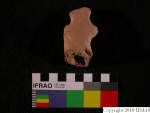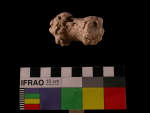Back to top: Figurines from Unit J4
Anthropomorphic figurines
Only two hollowed anthropomorphic figurines have been found during the excavations of J4 (q157.2, q190.2) . Since only fragments survived, determining the gender is not feasable.
Both figurines have a very minimalistic abstract appearance with no decorations or elaborate details, and both belong to the Mittani period where they were recovered from accumulation layer with no indication to any type of specific use of the area (domestic or otherwise).
|

|
Back to top: Figurines from Unit J4
Clay plaque
Clay plaque q16.1 pertains to the Early Akkaddian period, found in an accumulation layer dating to modern time. It depicts a soldier leading a naked prisoner. The only preserved portion of the plaque is the upper right corner. mKB gave a thorough iconographical analysis and style description that is cited here below.
Back to top: Figurines from Unit J4
Iconographic description
Two evenly spaced figures, a soldier on the left and a naked prisoner on the right. The head of the soldier is shown in profile facing right. He is wearing a head band but his hair above is not clear. The beard is shown as short thickened strands with the hint of curls at the bottom. His left shoulder is represented in front view with his arm rendered as wide near the shoulder, a pointed elbow and a thinner arm to the wrist. His left hand holds a cord used to restrain his prisoner. The prisoner is nude and rendered with his head in profile, shoulders in front view and the rest of his body in a rotated view with the change in direction coming at mid torso so that his legs and genitals are depicted in profile. Since he is shown walking, his left leg is forward, and his genitals are shown against the middle portion of his left leg. While a cord is tied around his neck, his hands are not fastened behind his back, as we have in other scenes of prisoners; his right arm is indicated as bent up across his chest. Unfortunately, his left arm is not preserved.
Back to top: Figurines from Unit J4
Style
The stylistic characteristics of this plaque indicate that it is Early Akkaddian in date. These include the details of the beard, the shape of the eyes, the extension of the lower stomach, and especially the rotated posture. The plaque is close in style to the fragment of a stone plaque discovered a number of years ago in A7. Both represent significant interaction between two figures, evenly spaced, with bodies in a rotated view. Other EDIII and early Akkadian scenes in registers depict soldiers restraining prisoners who are walking in front of them. While the rest of the plaque cannot be reconstructed with certainty, it probably also depicted other pairs of soldiers and naked prisoners. The imaging of captive prisoners is a favorite theme in late ED III and early Akkadian iconography, not only because the period is one of turmoil as the Akkadian dynasty sought to extend its imperial presence. The victories of the imperial army and the widespread images of their success, extending even in the popular culture of the period, contributed significantly to the image of power and prestige the dynasty wanted to create in the public perception. This perception was important to create not only in the minds of their immediate neighbors but also in the consciousness of states as far away as Urkesh.
Back to top: Figurines from Unit J4
Zoomorphic figurines
Twenty-one zoomorphic figurines have been recovered in J4. None are complete. Most of them consist of either a fragment of the torso, with or without the legs, or the neck area and head. The corpus of the zoomorphic figurines of J4 seems to conform with the rest of the corpus in terms of style and execution. It is difficult to determine the genus of the animals represented in most of the cases, since we only have fragments. However, it is safe to say, that most of the representations are of cattle.
In most of the representations, the shapes are slightly robust with simple silhouette and no decoration or incisions, except for the ones representing equids.
Back to top: Figurines from Unit J4
Lions
Figurine q28.1 might be a representation of a lion due to the robustness and length of the shape. And while the head is missing, there are traces of added clay on the neck area which might be a rendering of the lion’s mane.
|

|
Back to top: Figurines from Unit J4
Equids
Figurine q43.2 is the head of an equid. The neck portion shows horizontal strokes on both sides representing the mane of the horse, and the front of the head shows a representation of bangs. There is a perforation where the nostril is located. It is however unclear if it is meant to represent the nostrils or if it runs all the way through to the other side to serve the function of tying the harness of the horse to a chariot.
Figurine q153.1, the head and neck of a horse. The upper part of the neck shows a vertical elevated line representing the mane. On the head, there is a representation of a harness that is wrapped around the head and decorated with incised circles.
Figurine q236.1 is a fragment of an equid figurine where only parts of the neck and head are preserved. The mane is represented by arbitrary incised strokes giving an abstract rendering of hair. The mane is then perforated on the top part, probably to attach it to a harness or chariot.
Back to top: Figurines from Unit J4
Vessle figurines
Figurines q146.1 and q147.1 represents an unidentifiable animal with what appears to be a broken vessel on the head.
Figurine q192.1 is a figurine that most probably represents a pig. The shape of the body and silhouette are the factors from which I deterred the genus. The front of the body has a circular motif that is perforated in the middle. Another perforation is located above the circle. The figurine is hollowed, allowing us to assume that it was used as a liquid container that would be poured from these perforations.
Overall, the sample from J4 consists of figurines that can be divided into 4 categories:
1) figurines that were used for counting live stock (As Hauser argues that it was one of the zoomorphic figurine’s function).
2) Vessels (for ceremonies and other occasions).
3) Parts of chariot assemblies (hard to determine exact function of chariots).
4) Toys
Back to top: Figurines from Unit J4
Discussion
It is very peculiar to find such high number of figurines in an area like J4. One has to wonder about the reason, because J4 is not an area of heavy activities. These types of objects are usually associated with domestic or cultic spheres, or store houses like the case of the large number of animal figurines that were found in the royal store house of Urkesh. And to assume that these objects might have been dumped there is not very valid because J4 only contained one pit that might have been for storage or dumping, but the figurines are not associated with it (and neither were other objects).
The archaeological context of these finds is natural accumulation layers, mixed layers, a floor and a brick melt. All of them pertaining to Mittani or modern layers, when the temple terrace was no longer functioning at that area and the monumental access shifted to J5. The same cannot be said about the anthropomorphic figurines. Their low number actually conforms with my theory that the anthropomorphic representations were related more to a domestic sphere rather than the religious one in Urkesh where It is assumed that it was frowned upon to have them present in worship places.
The only plausible interpretation for the presence of such items in this area, based on their archaeological context, is that they were washed there after the area was not used anymore. Therefore, it is safe to assume that they were not used and had no function there, but they are in a secondary context.
When studying the zoomorphic figurines of J5, R. Hauser asks a question about “the possible relationship of the figurines and other artifacts to the pathway that led to the temple and their function with respect to their owners who were making this pilgrimage”. The number of zoomorphic figurines retrieved from J5 is similar to that of J4 (27 in J5). The number is very high in other units in the temple terrace area; unit J2 (67 figurines), J1 (60 figurines), J3 (37 figurines) and in J7 (7 figurines). What is peculiar is that the number of animal figurines is high in all the unites in the temple area, but the anthropomorphic figurines are almost absent from all these unites (2 in J4, 2 in J5 and very few fragments from J1). This lead the believe that there must have been a function related to these objects to have them there, even if their secondary context suggests that they were dumped or washed there, but they had to have a close primary context to end up there, and this context should reveal a clue about their use in an area that is considered sacred, or close to the sacred sphere.
Back to top: Figurines from Unit J4